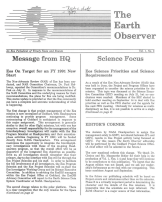



Recent Imagery
You will be directed to the NASA Visible Earth webpage when you select Images by Mission below, or click on the images at right that are randomly generated to represent four out of all possible topics.
The Earth Observer has a new look! Visit the NEW Earth Observer website.
The Earth Observer: Aug - Sep, 1989
In This Issue
Click title below to view page
no ToC exists; need to create/enter; NOTE: although labeled "Sep 1989" this issue covers Aug and Sep 1989. See Editor's Corner text for more info.
EDITOR'S CORNER
The decision by NASA Headquarters to assign Eos management solely to GSFC, not shared between JPL and GSFC, results in Eos Project activity being focussed at GSFC. For this reason The Earth Observer editorship will be performed by the Goddard Project Science Office. (A chief editor will be selected in the future.)
The new masthead reflects this change. We thank Dr. Cimino and Ms. Marguerite Schier for their help in the production of Vol. 1, Nos. 1-4 and hope they will continue to be contributors to this publication. We regret that the August edition was not issued, and we ask our readership's forbearance as we deal with our reorganizing. This issue combines August and September.
In the future our publishing schedule will be based on Project events and milestones rather than on the calendar. Phase B is a critically important period in determining the character and the details of the Eos missions. It is imperative that the scientists are kept informed. The Earth Observer is a major source of that information.
The other six instruments which were recommended for selection have been selected for concept definition. This form of selection implies that concept studies of the instruments will be conducted over the next three years and that eventual selection will be for deployment during ~he ope~ational phase of Freedom. All of the plans for mtegration of the attached payload investigations into the overall Eos mission will proceed. Dr. Gerald North of Texas A & M University will join the Eos IWG as an Instrument P.I. Dr. William Barnes of Goddard will become a MODIS Team Member and Drs. Krishnamurti and Fitzjarrald, of Florida State and Marshall, respectively, will become LAWS Team Members as the result of ~heir successful proposals of modifications to these facility mstruments.
None of the changes indicated above will alter the terms o~ the selection letters sent to Eos investigators by Dr. Fisk. All selected investigations will remain strong candidates for confirmation for execution until the appropriate reviews of their progress have been made. Final selection of the Eos-A payload is still planned for September 1990. Final selection of the Eos-B payload will be no earlier than September 1991. We hope to obtain more early funding for Eos, but the extent of this is still under discussion.
Dr. Fisk is supporting us in our plan to set aside a fixed percentage of the annual Eos funding to support an expanded program of graduate fellowships in Earth science. Eventually, more than 100 new graduate students will be supported in this manner in addition to those students funded as part of the selected Eos investigations and through our on-going research and analysis tasks. The currently estimated budget for Eos allocates 10% to funding of actual research; this figure does not include computers for investigators, software developers for instrument algorithms, or the development and operation of EosDIS. This level of funding will eventually support the full-time equivalent of 1000 Earth science researchers, and this support will extend for 20 years. This implies roughly a doubling in the number of Earth scientists supported by NASA.
We will keep you informed as the budget process proceeds.
—Dixon Butler and Stan Wilson
Read more...

